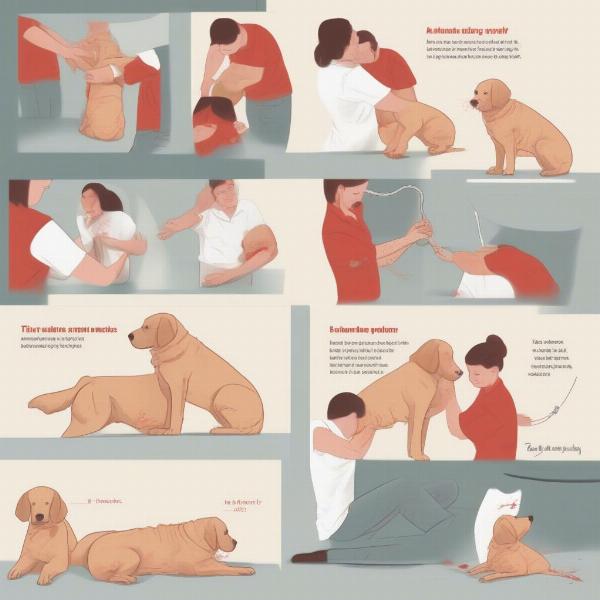A well-stocked dog first aid kit is a must-have for any responsible dog owner in the UK. From minor scrapes to more serious emergencies, being prepared can make all the difference in your dog’s recovery and well-being. This guide will walk you through the essentials for creating a comprehensive dog first aid kit specifically tailored to the UK environment and common canine ailments.
Essential Supplies for Your Dog First Aid Kit
Your dog first aid kit should be easily accessible, clearly labelled, and regularly checked for expired items. Consider storing it in a waterproof container and keeping it in a readily accessible location, like your car or near your dog’s lead. Here’s a breakdown of the must-haves:
- Antiseptic wipes or spray: For cleaning minor wounds and preventing infection. Opt for pet-friendly solutions to avoid irritation.
- Sterile gauze pads: For covering wounds and applying pressure to stop bleeding. Various sizes are useful.
- Adhesive bandages (vet wrap): Secure gauze pads and provide support to injured limbs. Self-adhering bandages are ideal.
- Cotton wool: Useful for cleaning wounds and applying antiseptic.
- Scissors: For cutting bandages and other materials. Rounded-tip scissors are safer for use around your dog.
- Tweezers: For removing splinters, ticks, and other foreign objects.
- Tick remover tool: Specifically designed to safely remove ticks, minimizing the risk of leaving the head embedded.
- Digital thermometer: To check your dog’s temperature. A normal dog’s temperature is between 38.3°C and 39.2°C.
- Syringe (without needle): For administering oral medications or flushing wounds.
- Sterile saline solution: For flushing wounds and eye irrigation. Single-use ampoules are convenient.
- Eye drops (artificial tears): To soothe irritated eyes. Always choose a formulation specifically designed for dogs.
- Antihistamine (consult your vet): For allergic reactions. Keep your vet’s recommended dosage instructions handy.
- Emergency contact information: Include your vet’s number, as well as an emergency out-of-hours contact.
- Muzzle: Even the gentlest dog can become agitated when injured. A muzzle can help protect you while administering first aid.
- Towel: Useful for keeping your dog warm, restraining them if necessary, or cleaning up spills.
What to Do in Common Emergency Situations
Knowing how to respond in an emergency can be crucial. Here’s a quick guide for handling common canine mishaps:
- Bleeding: Apply direct pressure to the wound with a clean cloth. If bleeding is severe, seek immediate veterinary attention.
- Burns: Cool the burn with cool (not cold) water. Do not apply ice. Seek veterinary care immediately.
- Choking: If your dog is choking, try to dislodge the object by carefully sweeping their mouth. If unsuccessful, perform the Heimlich maneuver (seek guidance from your vet on the correct technique for dogs).
- Seizures: Keep your dog safe from harm by moving furniture away. Do not restrain them. Time the seizure and contact your vet immediately.
 Handling Common Dog Emergencies
Handling Common Dog Emergencies
Building a UK-Specific Dog First Aid Kit
While the core components remain similar, certain additions can enhance your dog first aid kit for the UK environment:
- Styptic powder or pencil: Useful for stopping bleeding from minor cuts, particularly on the paws after walks in the countryside. styptic powder for dogs offers more details on this topic.
- Paw balm: Protects paws from harsh weather conditions, salt, and grit, common during UK winters.
- Fox poo remover: Fox faeces can carry parasites harmful to dogs. A dedicated remover can help sanitize affected areas.
Conclusion
Having a well-equipped dog first aid kit is a vital part of responsible dog ownership in the UK. By being prepared for common injuries and emergencies, you can provide immediate care and improve your dog’s chances of a swift recovery. Remember to regularly check and replenish your kit and consult with your vet for specific advice tailored to your dog’s breed and health needs.
FAQs
- What is the most important item in a dog first aid kit? Arguably, a clear understanding of how to use the items in the kit and when to seek professional veterinary help is crucial.
- Where should I store my dog first aid kit? Keep it accessible, preferably in a waterproof container, in your car and at home.
- Can I use human first aid products on my dog? Not always. Some human medications can be toxic to dogs. Stick to pet-friendly products and consult your vet.
- How often should I check my dog first aid kit? At least every six months to ensure medications haven’t expired and supplies are adequately stocked.
- Should I take a dog first aid course? Absolutely! A first aid course can equip you with the confidence and skills to handle emergencies effectively.
- What should I do if my dog ingests something toxic? Contact your vet or a pet poison hotline immediately.
- Is it necessary to muzzle my dog when injured? Even the most gentle dogs can bite when in pain. A muzzle is a safety precaution for both you and your dog.
Related Articles:
About ILM Dog:
ILM Dog provides expert advice on all aspects of dog care, from breed selection and health to training, nutrition, and grooming. We are dedicated to helping you provide the best possible care for your canine companion. Contact us for expert advice and support: Email: [email protected], Phone: +44 20-3965-8624.